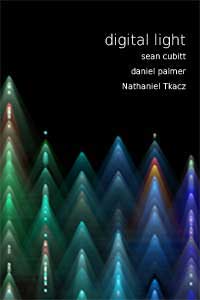Digital Light
edited by Sean Cubitt, Daniel Palmer and Nathaniel Tkacz

- Fibreculture Books
- Published: 2014
- ISBN: 978-1-78542-008-5
- PDF ISBN: 978-1-78542-000-9
Light symbolises the highest good, it enables all visual art, and today it lies at the heart of billion-dollar industries. The control of light forms the foundation of contemporary vision. Digital Light brings together artists, curators, technologists and media archaeologists to study the historical evolution of digital light-based technologies. Digital Light provides a critical account of the capacities and limitations of contemporary digital light-based technologies and techniques by tracing their genealogies and comparing them with their predecessor media. As digital light remediates multiple historical forms (photography, print, film, video, projection, paint), the collection draws from all of these histories, connecting them to the digital present and placing them in dialogue with one another.
Light is at once universal and deeply historical. The invention of mechanical media (including photography and cinematography) allied with changing print technologies (half-tone, lithography) helped structure the emerging electronic media of television and video, which in turn shaped the bitmap processing and raster display of digital visual media. Digital light is, as Stephen Jones points out in his contribution, an oxymoron: light is photons, particulate and discrete, and therefore always digital. But photons are also waveforms, subject to manipulation in myriad ways. From Fourier transforms to chip design, colour management to the translation of vector graphics into arithmetic displays, light is constantly disciplined to human purposes. In the form of fibre optics, light is now the infrastructure of all our media; in urban plazas and handheld devices, screens have become ubiquitous, and also standardised. This collection addresses how this occurred, what it means, and how artists, curators and engineers confront and challenge the constraints of increasingly normalised digital visual media.
While various art pieces and other content are considered throughout the collection, the focus is specifically on what such pieces suggest about the intersection of technique and technology. Including accounts by prominent artists and professionals, the collection emphasises the centrality of use and experimentation in the shaping of technological platforms. Indeed, a recurring theme is how techniques of previous media become technologies, inscribed in both digital software and hardware. Contributions include considerations of image-oriented software and file formats; screen technologies; projection and urban screen surfaces; histories of computer graphics, 2D and 3D image editing software, photography and cinematic art; and transformations of light-based art resulting from the distributed architectures of the internet and the logic of the database.
Digital Light brings together high profile figures in diverse but increasingly convergent fields, from academy award-winner and co-founder of Pixar, Alvy Ray Smith to feminist philosopher Cathryn Vasseleu.
“Digital Light will be an important book. It marks a moment in history at which we are coming to terms with a range of technological convergences that have profoundly shifted the status of image production and consumption. It maps the ways in which technologies employing light have evolved from their earliest manifestations into the somewhat multifarious, operational and highly distributed conditions of today. It collects a number of very significant, accomplished practitioners and thinkers, many of whom actively look back (historically) at how ways of working with light have altered, evolved and become tangled in other agendas, implications and dimensions. The rapid shifts in the status and role of photography – first in the move to digital photography and then to their embedded smart phone ubiquity and life on photo-sharing websites and social media, is a repeated theme that returns across many of the essays. Digital Light also deals with the way in which this shift (and others) give the image the status of data, the forms of embedded agency this entails, and the implicit interaction/intersection with dimensions beyond the ‘image’ per se, through ‘tagging’ of various sorts, algorithmic construction, and automated functions.”Pia Ednie-Brown – RMIT, Melbourne
Editor Bios
Sean Cubitt is Professor of Film and Television at Goldsmiths, University of London; Professorial Fellow of the University of Melbourne and Honorary Professor of the University of Dundee. His publications include Timeshift: On Video Culture, Videography: Video Media as Art and Culture, Digital Aesthetics, Simulation and Social Theory, The Cinema Effect and EcoMedia. His new book, The Practice of Light, will be published in 2014. He is the series editor for Leonardo Books at MIT Press. Current research is on the history and philosophy of visual technologies, on media art history and on ecocriticism and mediation.
Daniel Palmer is Associate Dean of Graduate Research and Senior Lecturer in the Art History & Theory Program at MADA (Monash Art, Design & Architecture). He has a long-standing involvement with the Centre for Contemporary Photography in Melbourne, as a former curator and current board member. His publications include the books Twelve Australian Photo Artists (2009), co-authored with Blair French, and the edited volume Photogenic: Essays/Photography/CCP 2000–2004 (2005). His scholarly writings on photography have appeared in journals such as Photographies, Philosophy of Photography and Angelaki, and he also contributes to art magazines including Art & Australia and Frieze.
Nathaniel Tkacz is Assistant Professor in the Centre for Interdisciplinary Methodologies at The University of Warwick. His books include Wikipedia and the Politics of Openness, Critical Point of View: A Wikipedia Reader (with Geert Lovink) and The MoneyLab Reader (with Geert Lovink and Patricia de Vries, forthcoming 2015). His current research is split between data, dashboard interfaces and governance, and the relationship between media and economy.
